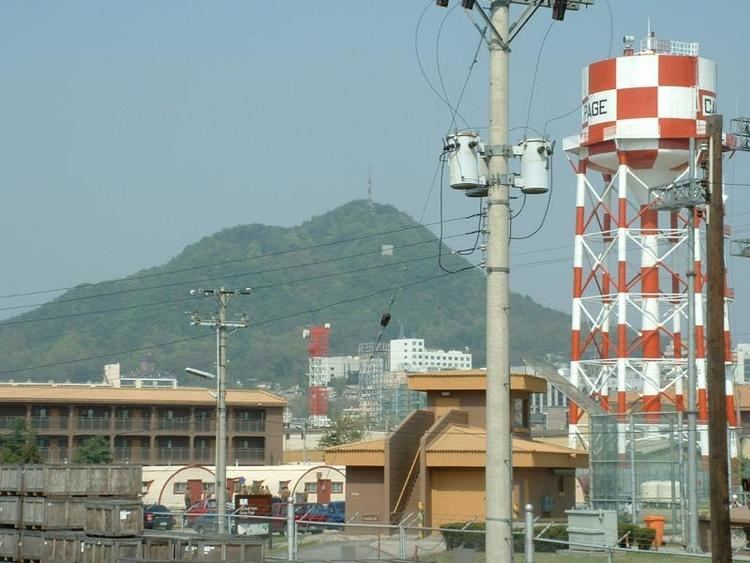 | ||
Camp page 286 koasel pegambiran untuk santai
Camp Page also known as K-47 Air Base was a former US Army base located near Chunchon, South Korea which was closed on 1 April 2005. It enclosed 157.2 acres in North Central South Korea, near Chunchon City, 48 miles north of Seoul, in the Kangwon province. It remains in use by the Republic of Korea Army as an army aviation base. As of 28 October 2016, the only remaining structure on the site of the former Camp Page is the water tower. The land has been converted to urban expansion.
Contents
- Camp page 286 koasel pegambiran untuk santai
- Camp page 286 koasel sorak sorak manusia
- Base history
- Major units
- Base closure
- Pollution concerns
- References

Camp page 286 koasel sorak sorak manusia
Base history
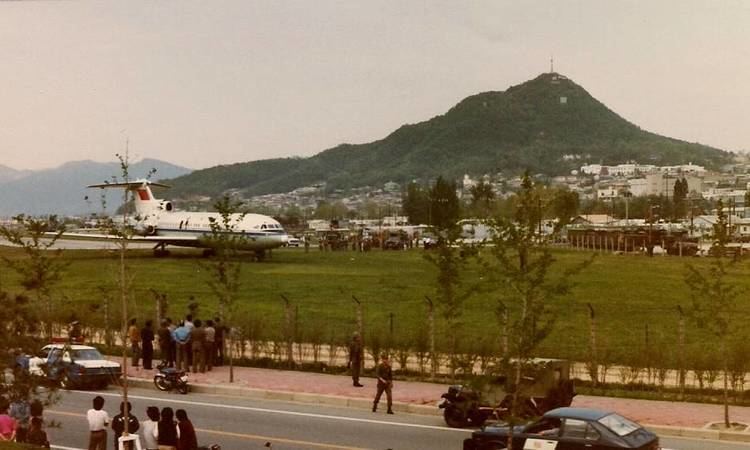
"Citizens from the South Korean city of Chunchon said goodbye to U.S. soldiers serving at Camp Page in a ceremony last week marking the end of a 54-year mission. The base, it’s major feature an airstrip built after Chunchon was recaptured from communist forces in March 1951, is due to close by the end of next month, officials have said. The U.S. 8th Army announced this week that one of the Camp Page units, the 542nd Medical Evacuation Company, including about 120 soldiers and their equipment, will move to Fort Campbell, Ky., by April. Another Camp Page unit, the 1st Battalion, 2nd Aviation Regiment, will move to Camp Eagle, near the South Korean city of Wonju, about an hour’s drive south of Chunchon, according to an 8th US Army statement."
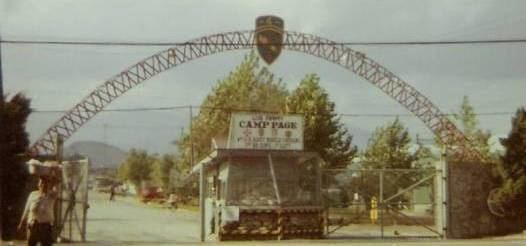
"In 1951, Eighth US Army engineers prepared the runway in a burned out section of a newly recaptured town, at what would become Camp Page. On 30 January 1958 the last units of the 100th Field Artillery Rocket Battalion arrived from Japan taking up headquarters at what was known as Camp Page. Subsequently the Battalion was joined by Infantry, Engineer, Signal and Supply units and was redesigned the 4th Missile Command, a major subordinate command of the Eighth United States Army. The "Last of a Breed," the 4th Missile Command celebrated its 20th and final anniversary on 27 April 1978 and was totally inactivated in June 1978. Only the Weapons Support Detachment-Korea was retained to carry on the rites of St. Barber, and it to was inactivated in September 1990."
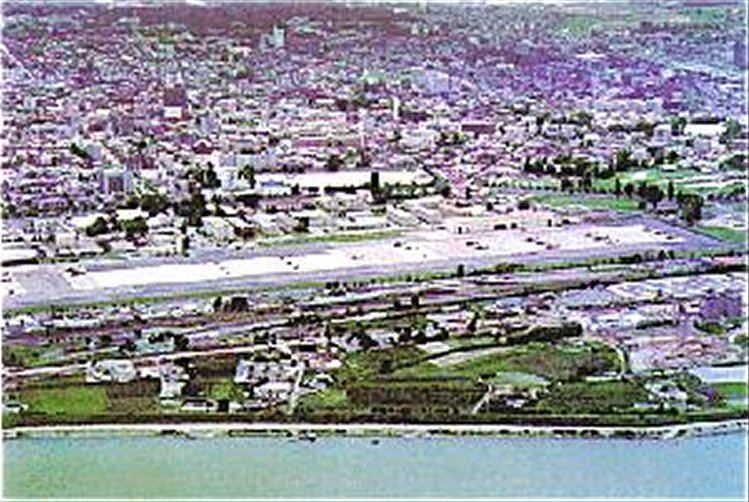
USAG Camp Page was named in honor of Medal of Honor recipient Lt. Col. John U. D. Page. John Upshur Dennis Page (February 8, 1904 – December 11, 1950) was a United States Army officer from Saint Paul, Minnesota. Lieutenant Colonel Page received the Medal of Honor for his actions in the Battle of Chosin Reservoir during the Korean War.
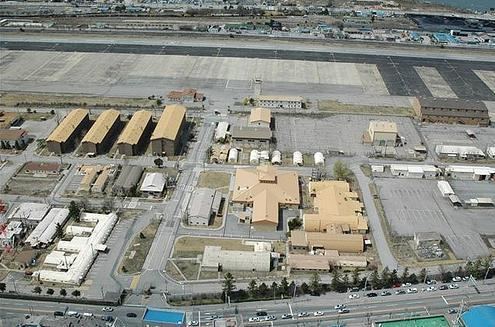
Other American servicemen who were honored at Camp Page for their ultimate sacrifice included Staff Sergeant Robert E. Quash, who died of a heart attack while with the First Battalion of the 42nd Artillery. He was only 30 years old, and was a native of Junction City, Kansas. In memoriam, a tree was planted in his honor on the post.

Another American serviceman died on the post. A/Sgt Reginald L. Alexander, "Who died in the performance of duty for his country." He died on December 27, 1977, at age 22. A memorial plaque in his honor was placed on the grounds of Camp Page.
There were 152 buildings on the site in 2006, enclosing 725,733 square feet.
"In 1964, 2nd Lt. William Ford, a recent graduate of the University of Oklahoma Army ROTC program, was headed to South Korea for his first assignment. 2nd Lt. William Ford poses with the Fourth Launcher Section, Battery B, 1st Missile Battalion, 42nd Artillery at Camp Page, South Korea in June 1965. Upon arrival in Korea, the young Field Artillery Officer was assigned to Bravo Battery, 1st Battalion, 42nd Field Artillery at Camp Page near Chuncheon. His unit maintained responsibility for artillery in the defense of the Korean Demilitarized Zone."
A Chinese commercial airplane was hijacked by six defectors in 1983, who forced the plane to fly over North Korea airspace and landed the airplane safely at Camp Page. "US Officials said the three engine jet, which resembles a Boeing 727, landed at Camp Page, an American military base near Chunchon. Later, another newspaper reported the fate of the hijackers: "In 1983, six Chinese hijacked a plane to South Korea. They were imprisoned for less than a year and resettled in Taiwan, where they received heroes' welcomes." Another newspaper wrote about the diplomatic aspects of the hijacking. "When six Chinese defectors hijacked a domestic airliner to South Korea last week, they unwittingly initiated a breakthrough in Chinese-South Korean relations. The airliner, a British-built Trident with 105 people on board, was on a scheduled flight from Shenyang in Manchuria to Shanghai. An hour after takeoff, the hijackers shot their way into the cockpit and eventually forced the pilot to land the plane in South Korea. But as the immediate drama of the situation faded, it was replaced by excitement over the longer-term implications of the incident. From the South Korean point of view, better relations with North Korea's main ally could help to lessen tension on the divided peninsula and would considerably strengthen the south's position vis-a-vis North Korea."
The NCO Academy was another function at Camp Page during the mid 70s.
Major units
Major military units at Camp Page included: 1st Battalion, 2nd Aviation. Provided aviation support for the 2nd Infantry Division. Major Robert Young was the Commander of the 1/501 Aviation 17th Aviation Brigade, U.S. Army, Camp Page, Korea, from 1990-1991. Richard Vincent Melnyk was the "Attack platoon leader 1-2 Aviation Regiment, U.S. Army, Camp Page, Korea, 1997." "Camp Page was the home of the Apache unit linked to the 2nd Infantry at the DMZ. Camp Page consisted of 157 acres supporting the 1st Battalion, 2nd Aviation Regiment and the 542nd Medical Company. The population of the camp was approximately 1300, with 700 of that being US Military personnel and 650 being civilians employed by the Department of the Army. When the facility closed it covered 145 acres with 173 buildings, 1,067 service members and civilians in 15 tenant units. Its primary mission was to provide aviation support for 2nd Infantry Division."
Active duty personnel in 1998: 700. Civilian: 650. All personnel live on post; most served a one-year unaccompanied tour of duty. Kyong-Ku Yun was a "civil engineer, Deh Camp Page, US Army, Chuncheon, Republic of Korea, from 1989 to 1991."
Commercial activities included a barber shop, convenience store, tailor, Class VI Post Exchange, burger bar, airline ticket office, pizze delivery.
Schools: remote college courses and correspondence programs were offered, although there were no on-base schools.
There was a base library on the post that was operated as a Non-Appropriated Fund Instrumentality (NAFI). Robert Lee Hadden was the "Supervisory librarian, USAG Camp Page, Chunchon, 1983-1984."
Recreational facilities included a recreation center; pool; tennis courts, craft shop, community club, basketball. Concerning the temporary bowling facility, one report said: "Only one installation (Camp Page) of the forty studied had bowling centers in temporary buildings. The percent permanent factor for the bowling center at Camp Page was 0.00, the other installations had a percent permanent factor of 10.00."
Base closure
Camp Page, near Chunchon, ROK, was the home of the Apache helicopter unit linked to the 2nd Infantry at the Demilitarized Zone until it was closed in 2005.
"On 1 April 2005 Camp Page closed and preparations were made to transfer ownership of the facility to the Republic of Korea. This transfer was completed in 2005. Mention of this shift was made in US-ROK Land Partnership Plan in 2002, when the expected date of closure was 2011." "Camp Page is actually a good place to be stationed because it is located so far away from the rest of 2ID and is in a great area of Chuncheon. However, the base is located in the middle of the city near the river which has become a burden on the city with the continued development of Chuncheon. The noise of the helicopters, on this former aviation base, coming and going every day from this location in the city probably does get annoying after a while for nearby residences. Expect more base closures to come."
Pollution concerns
There are many concerns about the amount of pollution in the soil and groundwater in Camp Page. "According to the newspaper, the survey showed that soil contamination levels at Camp Page in Chuncheon stood at more than 100 times above the permissible level. Samples from all eight installations tested for ground water pollution revealed toxins that exceeded permissible levels, the newspaper reported... “Camp Page in the city of Chuncheon tops the list for oil leakage pollution among those bases,” Kang Sung-min, chief aide to Korean National Assemblyman Kim Hyung-ju, told Stars and Stripes on Thursday."
"Levels of BTEX, a group of four chemicals that make up a large percentage of petroleum products, at Camp Page registered at 1,152 milligrams per kilogram of soil. South Korea’s national standards call for “anti-contamination measures” at 200 milligrams per kilogram of soil. Benzene, one of the chemicals in BTEX, is listed by the EPA [ U.S. Environmental Protection Agency ] as a known carcinogen. The EPA’s maximum permissible level for benzene in drinking water is 5 parts per billion, or .005 milligrams per liter/kilogram. Total petroleum hydrocarbons, which can include several chemicals, also showed elevated levels. Levels at Camp Page registered 50,552 milligrams per kilogram of soil. Camps Howze, Greaves, Stanton and Garry Owen ranged between 20,767 and 47,819 milligrams per kilogram of soil. South Korea’s national standards call for anti-contamination measures at 1,200 milligrams per kilogram of soil, according to Green Korea, which filed a lawsuit against the South Korean government for full release of its base environmental data."
There are also concerns about an undocumented accident with a nuclear tipped missile accident at the former Camp Page installation. "The online edition of the magazine SisaIN reports that a retired US soldier who served at Camp Page in Chuncheon from 1972 to 1973 is claiming that in summer of 1972, there was an accident involving a nuclear tipped Honest John missile. According to Dallas Snell, who also claimed Agent Orange was buried at Camp Page, his post-lunch R&R was disturbed one day when the base siren went off. About 20—30 men and MPs, including Snell, gathered in the base’s nuke silo, and were ordered to take defensive positions around a nuke-tipped Honest John. Something had gone wrong with the warhead, he said, and a helicopter came and transported it out."
There are also concerns about allegations that Agent Orange were buried at the site. "Last week, some retired American soldiers raised a second allegation that Agent Orange was buried at a former U.S. base, Camp Page, in Chuncheon. Camp Page was turned over to South Korea in 2005. “We will open a further investigation on suspicion that the defoliant was buried at Camp Page in Chuncheon,” Vice Defense Minister Lee Yong-gul told reporters. “After reviewing other allegations that Agent Orange was buried at other former U.S. military bases, we will consider expanding our investigation if necessary.” Ministry officials said the investigation at Camp Page would start as early as next week."
